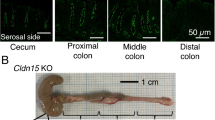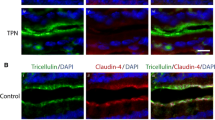Abstract
Cholera toxin is commonly known to induce chloride secretion of the intestine. In recent years, effects on epithelial barrier function have been reported, indicating synergistic co-regulation of transporters and tight junction proteins. Our current study focused on the analysis of cholera toxin effects on transepithelial resistance and on tight junction proteins, the latter known as structural correlates of barrier function. Ligated segments of the rat jejunum were injected with buffered solution containing cholera toxin (1 μg/ml) and incubated for 4 h. Subsequently, selfsame tissue specimens were mounted in Ussing chambers, and cholera toxin (1 μg/ml) was added on the apical side. Transepithelial resistance and permeability of sodium fluorescein (376 Da) were analyzed. Subsequently, tissues were removed, expression and localization of claudins were analyzed, and morphological studies were performed employing transmission electron microscopy and confocal laser scanning microscopy. Cholera toxin induced a marked decrease in transepithelial resistance in the rat jejunal epithelium and an increase in paracellular permeability for sodium fluorescein. Immunoblotting of tight junction proteins revealed an increase in claudin-2 signals, which was verified by confocal laser scanning immunofluorescence microscopy, and a decrease in tricellulin, whereas other tight junction proteins remained unchanged. Transmission electron microscopy showed a reduction in the number of microvilli after incubation with cholera toxin. Moreover, cholera toxin led to a widening of the intercellular space between enterocytes. In accordance with the commonly known prosecretory effect of cholera toxin, our study revealed a complementary effect on small intestinal barrier function and integrity, which might constitute a pathomechanism with high relevance for prevention and therapeutic approaches.





Similar content being viewed by others
References
Alzamora R, O’Mahony F, Harvey BJ (2011) Estrogen inhibits chloride secretion caused by cholera and Escherichia coli enterotoxins in female rat distal colon. Steroids 76:867–876. https://doi.org/10.1016/j.steroids.2011.04.016
Amasheh S, Meiri N, Gitter AH, Schöneberg T, Mankertz J, Schulzke JD, Fromm M (2002) Claudin-2 expression induces cation-selective channels in tight junctions of epithelial cells. J Cell Sci 115(Pt 24:4969–4976. https://doi.org/10.1242/jcs.00165
Amasheh S, Milatz S, Krug SM, Bergs M, Amasheh M, Schulzke JD, Fromm M (2009) Na+ absorption defends from paracellular back-leakage by claudin-8 upregulation. Biochem Biophys Res Commun 378(1):45–50. https://doi.org/10.1016/j.bbrc.2008.10.164
Castellani S, Favia M, Guerra L, Carbone A, Abbattiscianni AC, Di Gioia S, Casavola V, Conese M (2017) Emerging relationship between CFTR, actin and tight junction organization in cystic fibrosis airway epithelium. Histol Histopathol 32(5):445–459. https://doi.org/10.14670/HH-11-842
Clarke LL, Grubb BR, Gabriel SE, Smithies O, Koller BH, Boucher RC (1992) Defective epithelial chloride transport in a gene-targeted mouse model of cystic fibrosis. Science 257(5073):1125–1128
De Lisle RC (2014) Disrupted tight junctions in the small intestine of cystic fibrosis mice. Cell Tissue Res 355(1):131–142. https://doi.org/10.1007/s00441-013-1734-3
DiBona DR, Chen LC, Sharp GW (1974) A study of intercellular spaces in the rabbit jejunum during acute volume expansion and after treatment with cholera toxin. J Clin Invest 53(5):1300–1307
Fan S, Harfoot N, Bartolo RC, Butt AG (2012) CFTR is restricted to a small population of high expresser cells that provide a forskolin-sensitive transepithelial Cl- conductance in the proximal colon of the possum Trichosurus vulpecula. J Exp Biol 215(Pt 7:1218–1230. https://doi.org/10.1242/jeb.061176
Gabriel SE, Brigman KN, Koller BH, Boucher RC, Stutts MJ (1994) Cystic fibrosis heterozygote resistance to cholera toxin in the cystic fibrosis mouse model. Science 266(5182):107–109
Guichard A, Cruz-Moreno B, Aguilar B, van Sorge NM, Kuang J, Kurkciyan AA, Wang Z, Hang S, Pineton de Chambrun GP, McCole DF, Watnick P, Nizet V, Bier E (2013) Cholera toxin disrupts barrier function by inhibiting exocyst-mediated trafficking of host proteins to intestinal cell junctions. Cell Host Microbe 14(3):294–305. https://doi.org/10.1016/j.chom.2013.08.001
Ikenouchi J, Furuse M, Furuse K, Sasaki K, Tsukita S, Tsukita S (2005) Tricellulin constitutes a novel barrier at tricellular contacts of epithelial cells. J Cell Biol 171:939–945. https://doi.org/10.1083/jcb.200510043
Krug SM, Amasheh S, Richter JF, Milatz S, Günzel D, Westphal JK, Huber O, Schulzke JD, Fromm M (2009) Tricellulin forms a barrier to macromolecules in tricellular tight junctions without affecting ion permeability. Mol Biol Cell 20:3713–3724. https://doi.org/10.1091/mbc.e09-01-0080
Liu X, Yang G, Geng XR, Cao Y, Li N, Ma L, Chen S, Yang PC, Liu Z (2013) Microbial products induce claudin-2 to compromise gut epithelial barrier function. PLoS One 8:e68547. https://doi.org/10.1371/journal.pone.0068547
Marinaro M, Staats HF, Hiroi T, Jackson RJ, Coste M, Boyaka PN, Okahashi N, Yamamoto M, Kiyono H, Bluethmann H, Fujihashi K, McGhee JR (1995) Mucosal adjuvant effect of cholera toxin in mice results from induction of T helper 2 (Th2) cells and IL-4. J Immunol 155(10):4621–4629
Markov AG, Veshnyakova A, Fromm M, Amasheh M, Amasheh S (2010) Segmental expression of claudin proteins correlates with tight junction barrier properties in rat intestine. J Comp Physiol B 180(4):591–598. https://doi.org/10.1007/s00360-009-0440-7
Markov AG, Falchuk EL, Kruglova NM, Rybalchenko OV, Fromm M, Amasheh S (2014) Comparative analysis of theophylline and cholera toxin in rat colon reveals an induction of sealing tight junction proteins. Pflugers Arch 466(11):2059–2065. https://doi.org/10.1007/s00424-014-1460-z
Matchkov VV, Krivoi II (2016) Specialized functional diversity and interactions of the Na,K-ATPase. Front Physiol 7:179. https://doi.org/10.3389/fphys.2016.00179
Mathan MM, Chandy G, Mathan VI (1995) Ultrastructural changes in the upper small intestinal mucosa in patients with cholera. Gastroenterology. 109(2):422–430
Molenda N, Urbanova K, Weiser N, Kusche-Vihrog K, Günzel D, Schillers H (2014) Paracellular transport through healthy and cystic fibrosis bronchial epithelial cell lines–do we have a proper model? PLoS One 9(6):e100621. https://doi.org/10.1371/journal.pone.0100621
Nilsson HE, Dragomir A, Lazorova L, Johannesson M, Roomans GM (2010) CFTR and tight junctions in cultured bronchial epithelial cells. Exp Mol Pathol 88(1):118–127. https://doi.org/10.1016/j.yexmp.2009.09.018
Radloff J, Cornelius V, Markov AG, Amasheh S (2019) Caprate modulates intestinal barrier function in porcine Peyer’s patch follicle-associated epithelium. Int J Mol Sci 20(6):E1418. https://doi.org/10.3390/ijms20061418
Rajasekaran SA, Beyenbach KW, Rajasekaran AK (2008) Interactions of tight junctions with membrane channels and transporters. Biochim Biophys Acta 1778(3):757–769
Rosenthal R, Milatz S, Krug SM, Oelrich B, Schulzke JD, Amasheh S, Günzel D, Fromm M (2010) Claudin-2, a component of the tight junction, forms a paracellular water channel. J Cell Sci 123(Pt 11:1913–1921. https://doi.org/10.1242/jcs.060665
Rybalchenko OV, Bondarenko VM, Orlova OG, Markov AG, Amasheh S (2015) Inhibitory effects of Lactobacillus fermentum on microbial growth and biofilm formation. Arch Microbiol 197(8):1027–1032. https://doi.org/10.1007/s00203-015-1140-1
Tamura A, Kitano Y, Hata M, Katsuno T, Moriwaki K, Sasaki H, Hayashi H, Suzuki Y, Noda T, Furuse M, Tsukita S, Tsukita S (2008) Megaintestine in claudin-15-deficient mice. Gastroenterology 134(2):523–534. https://doi.org/10.1053/j.gastro.2007.11.040
Tanaka H, Tamura A, Suzuki K, Tsukita S (2017) Site-specific distribution of claudin-based paracellular channels with roles in biological fluid flow and metabolism. Ann N Y Acad Sci 1405(1):44–52. https://doi.org/10.1111/nyas.13438
Wada M, Tamura A, Takahashi N, Tsukita S (2013) Loss of claudins 2 and 15 from mice causes defects in paracellular Na+ flow and nutrient transport in gut and leads to death from malnutrition. Gastroenterology 144(2):369–380. https://doi.org/10.1053/j.gastro.2012.10.035
Yu AS (2009) Molecular basis for cation selectivity in claudin-2-based pores. Ann N Y Acad Sci 1165:53–57. https://doi.org/10.1111/j.1749-6632.2009.04023.x
Yu W, Hussey Freeland DM, Nadeau KC (2016) Food allergy: immune mechanisms, diagnosis and immunotherapy. Nat Rev Immunol 16:751–765. https://doi.org/10.1038/nri.2016.111
Funding
This research was sponsored by a grant from the Russian Research Foundation (No. 18-15-00043), a grant from the Saint Petersburg State University (No. 0.37.218.2016), a grant from the Deutsche Forschungsgemeinschaft (AM 141/11-1), and the Partnership Program Freie Universität Berlin-Saint Petersburg State University.
Author information
Authors and Affiliations
Contributions
Performed research: AGM, ONV, LSO, AAF, NMK, OVR
Analyzed data: AGM, JRA, SA
Contributed new methods or models: AGM, JRA, SA
Wrote the paper: AGM, JRA, SA
Corresponding author
Ethics declarations
Conflict of interest
The authors declare that they have no conflict of interest.
Additional information
Publisher’s note
Springer Nature remains neutral with regard to jurisdictional claims in published maps and institutional affiliations.
Rights and permissions
About this article
Cite this article
Markov, A.G., Vishnevskaya, O.N., Okorokova, L.S. et al. Cholera toxin perturbs the paracellular barrier in the small intestinal epithelium of rats by affecting claudin-2 and tricellulin. Pflugers Arch - Eur J Physiol 471, 1183–1189 (2019). https://doi.org/10.1007/s00424-019-02294-z
Received:
Revised:
Accepted:
Published:
Issue Date:
DOI: https://doi.org/10.1007/s00424-019-02294-z




